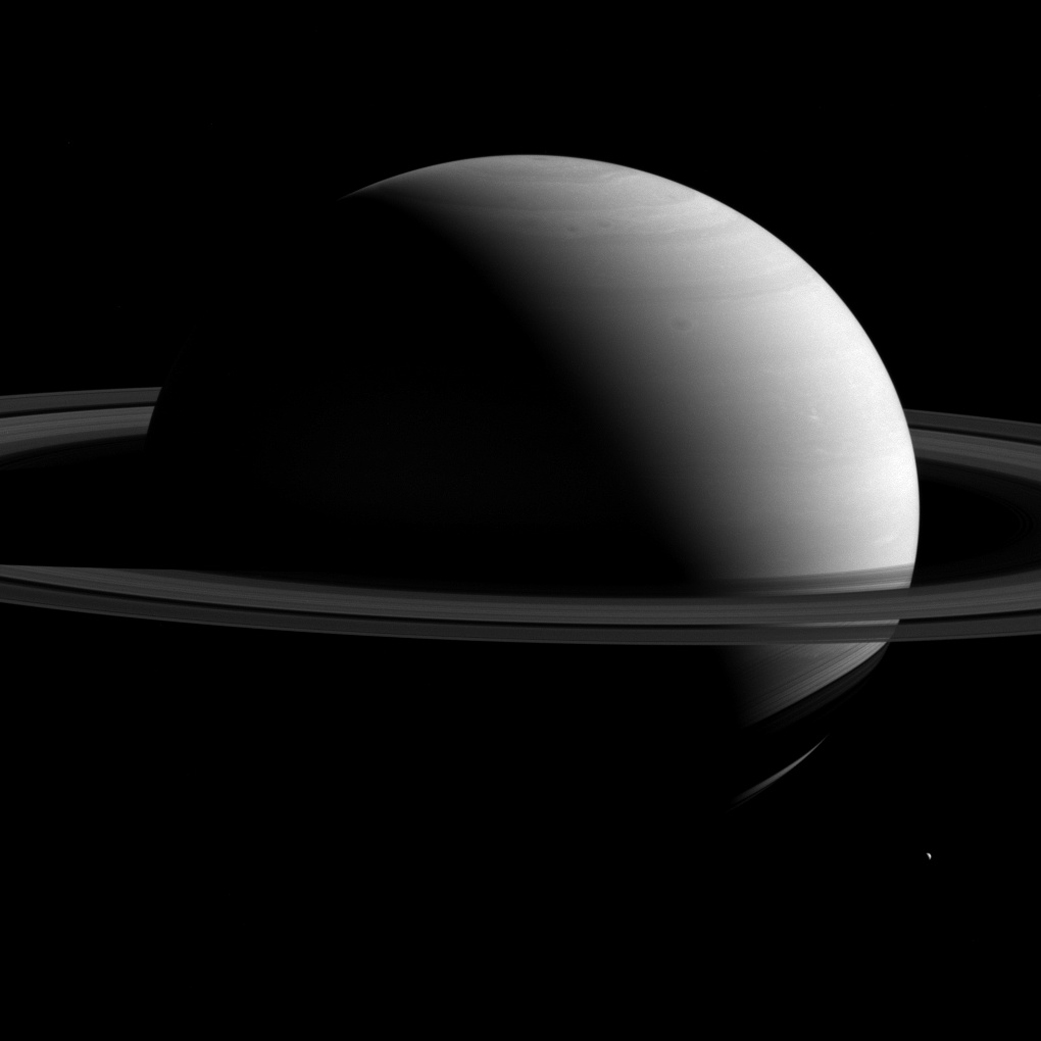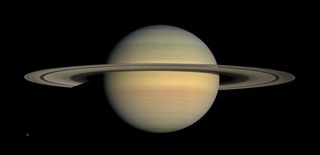Saturn Looks Regal in Cassini Photo, Methane Gas and All

A new black-and-white photograph taken by the Cassini probe shows the methane gas on Saturn, and captures the planet's regal air.
The sixth planet from the sun is often defined by its system of rings, but the body of Saturn is also an incredible sight to behold. Though not as flamboyant as Jupiter, which seems to have countless number of colorful stripes and brilliant spots, Saturn still has a regal quality to it.
In this image, Cassini captured wavelengths of light that are absorbed by methane — darker regions indicate more methane. Looking down on the tiny moon Dione, Saturn is imposing and powerful, giving the impression of royalty, while its ring system serves as a finely crafted crown.
The Cassini mission is nearing the end of its incredible exploration of Saturn. In 2017, the probe will execute a series of death-defying dives through the planet's ring system, before crashing into the surface of the planet. This view was taken at a distance of about 819,000 miles (1.32 million kilometers) from Saturn.
In the new image, taken Sept. 6, 2015, the darker regions of the planet are places where the light travels deeper into Saturn's gaseous atmosphere. The deeper the light travels, the more of it is absorbed by methane, before bouncing off clouds and reflecting back out, away from the planet.

Saturn's moon Dione is only 689 miles (1,123 km) across. It is one of 53 known moons orbiting Saturn. In the image, the light from Dione has been brightened to make it more visible.
The Cassini mission, a joint venture by NASA, the European Space Agency and the Italian Space Agency, began as the Cassini-Huygens mission. After dropping the Huygens probe onto the surface of Saturn's largest moon, Titan, in 2005, the Cassini probe continued to explore the Saturn system.
Get the Space.com Newsletter
Breaking space news, the latest updates on rocket launches, skywatching events and more!
The Cassini-Huygens mission has led to many discoveries about the wild and wonderful Saturn system, including evidence of liquid water on the moon Enceladus, 50-mile landslides on the moon Iapetus, and a giant methane lake on Titan. The mission also discovered a new ring 8 million miles (12.9 million km) away from Saturn.
Follow Calla Cofield @callacofield. Follow us @Spacedotcom, Facebook and Google+. Original article on Space.com.
Join our Space Forums to keep talking space on the latest missions, night sky and more! And if you have a news tip, correction or comment, let us know at: community@space.com.

Calla Cofield joined Space.com's crew in October 2014. She enjoys writing about black holes, exploding stars, ripples in space-time, science in comic books, and all the mysteries of the cosmos. Prior to joining Space.com Calla worked as a freelance writer, with her work appearing in APS News, Symmetry magazine, Scientific American, Nature News, Physics World, and others. From 2010 to 2014 she was a producer for The Physics Central Podcast. Previously, Calla worked at the American Museum of Natural History in New York City (hands down the best office building ever) and SLAC National Accelerator Laboratory in California. Calla studied physics at the University of Massachusetts, Amherst and is originally from Sandy, Utah. In 2018, Calla left Space.com to join NASA's Jet Propulsion Laboratory media team where she oversees astronomy, physics, exoplanets and the Cold Atom Lab mission. She has been underground at three of the largest particle accelerators in the world and would really like to know what the heck dark matter is. Contact Calla via: E-Mail – Twitter











